Inflatable boats have become increasingly popular in recent decades due to their lightweight construction and versatility. Made with flexible tubes and coated fabrics, inflatable boats can be easily stored when deflated and transported. When inflated, they provide buoyancy for work and recreation.
Inflatable boats come in two main varieties: soft-hulled and rigid-hulled inflatable boats (RIBs). Soft-hulled boats lack a rigid hull structure, while RIBs incorporate rigid flooring and sides for increased strength. Common lengths range from 2 to 7 meters. Both varieties are powered by outboard motors ranging from 2.3 to 300 horsepower.
Some key attributes that have propelled the rise of inflatable boats include:
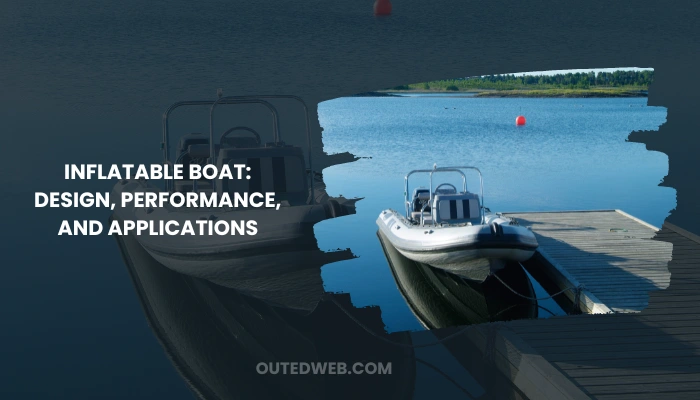
- Portability: When deflated, boats fold up small and fit into carry-on bags for transport in vehicles.
- Low cost: Inflatable boat construction uses affordable materials like coated fabrics and PVC.
- Maneuverability: Their nimble design allows access to shallow areas that are poorly suited for larger boats.
- Safety: Their buoyant tubes provide floatation in capsizes and their shape resists swamping.
Typical inflatable boat applications
| Application | Example |
| Recreational use | Fishing, watersports |
| Dive boat | Short trips to dive sites |
| Lifeboat | RNLI IB1 and RIBs for backup |
| Military | SEAL delivery and cargo transport |
| Water rescue | Coast guards and lifeguards |
While inflatable boats deliver versatility, their flexible structure also presents new design challenges compared to rigid vessels. This article examines key aspects of their performance, optimization, and more.
History of Inflatable Boats
Inflatable boats have come a long way from their humble beginnings as primitive flotation devices. The ingenuity of ancient civilizations paved the way for the modern marvels we enjoy today. Let’s embark on a journey through time and unravel the captivating evolution of these versatile watercraft.
Ancient Origins
In the distant past, our ancestors realized the buoyant potential of inflated animal skins. These ingenious floats were used to cross rivers, showcasing the resourcefulness of early humans.
However, it was the groundbreaking discovery of vulcanized rubber by Charles Goodyear in 1838 that truly revolutionized the world of inflatable boats.
Goodyear’s patented process stabilized rubber, making it durable and flexible. Simultaneously, Thomas Hancock in England developed a similar technique, sparking a legal battle over the innovative material.
This friendly competition fueled rapid advancements, with inventive minds exploring the boundless possibilities of rubber-coated fabrics.
Pioneers of Inflatable Boats
In the mid-19th century, British naval officer Lieutenant Peter Halkett became a trailblazer in the realm of inflatable boats. His designs, made from rubber-impregnated fabric, were intended for Arctic exploration.
The Halkett boat was a true marvel—a waterproof poncho that could be inflated into a one-man vessel, complete with a built-in bellow for inflation and a walking stick that doubled as a paddle.
While the Admiralty initially dismissed Halkett’s creations, explorers like John Franklin quickly recognized their potential. Franklin even took one on his ill-fated 1845 expedition, where the entire crew tragically vanished. This early adoption marked the beginning of a new era in watercraft design.
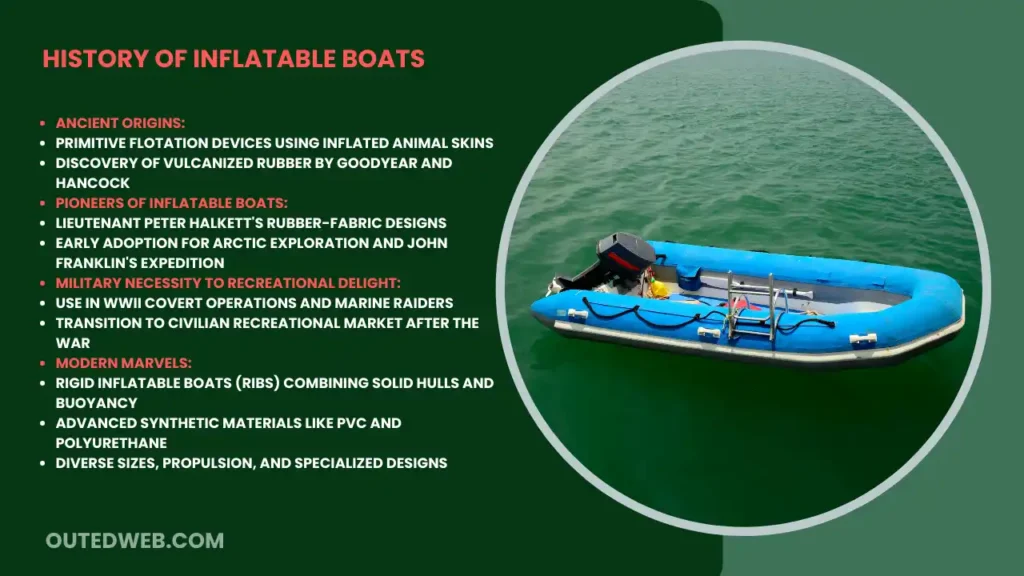
From Military Necessity to Recreational Delight
The extraordinary utility of inflatable boats became evident during World War II. Submarine warfare and the need for covert operations propelled their use by various military forces.
The Marine Raiders were trained to execute raids and landings from Landing Craft Rubber Large (LCRL) inflatables, showcasing their versatility in combat situations.
After the war, surplus inflatable boats found their way into civilian hands, igniting a passion for recreational activities on lakes, rivers, and oceans.
Companies like Zodiac and RFD led the charge, manufacturing user-friendly designs for diving, fishing, and whitewater rafting enthusiasts.
Modern Marvels
Today’s inflatable boats have evolved into true engineering marvels. The introduction of rigid inflatable boats (RIBs) combined the stability of a solid hull with the buoyancy of inflatable tubes, offering a smooth and powerful ride.
Moreover, advancements in synthetic materials like PVC and polyurethane have resulted in lightweight, durable, and airtight sponsons.
With a diverse array of sizes, propulsion systems, and specialized features, modern inflatable boats cater to a wide range of needs.
From high-speed offshore racing to luxury yacht tenders, these versatile vessels continue to push the boundaries of what’s possible on the water.
As we reflect on the fascinating journey of inflatable boats, we can’t help but marvel at the ingenuity and perseverance of those who dared to dream.
From ancient floats to cutting-edge watercraft, these buoyant marvels have captivated generations, proving that the human spirit can overcome any obstacle—even the depths of vast oceans.
Design Principles and Materials
Ah, the design principles and materials behind inflatable boats—it’s where the real magic happens, my friend! Let’s dive right in, shall we?
Hull Construction
When it comes to the hull, you’ve got two main options: rigid or inflatable. Rigid hulls, typically made of fiberglass, aluminum, or composites, offer unmatched durability and stability.
They’re the backbone of those burly RIBs (Rigid Inflatable Boats) you see carrying marines or slicing through choppy waters.
In contrast, pneumatic hulls are the defining characteristic of inflatables (or inflatable boats). These vessels are constructed using durable, airtight materials like Hypalon or reinforced PVC.
While they might appear insubstantial at first glance, don’t underestimate them—these boats can handle a lot of punishment!
Inflation Systems
Speaking of inflatables, let’s talk about those life-giving tubes that line the gunwales. They’re not just for show, you know?
These tubes are usually crafted from the same rugged materials as the inflatable hulls, ensuring they can withstand the harshest conditions.
However, there’s a catch: Maintaining the appropriate air pressure is essential. If it’s too low, you risk jeopardizing the boat’s stability.
If it’s too high, you might feel like you’re on a balloon! Fortunately, modern inflation systems make it simple to achieve the ideal pressure measurement (PSI).
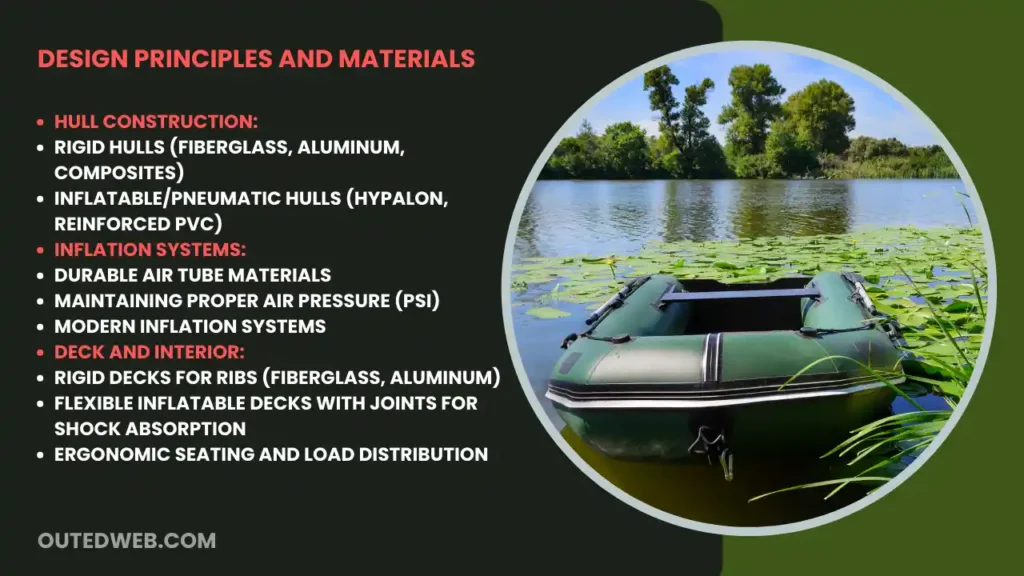
Deck and Interior
Excellent! Now that we’ve addressed the hull and tubes, let’s delve into the deck! This is where things become truly fascinating.
On RIBs, the deck is typically a rigid structure, often made from molded fiberglass or aluminum. But on IBs, we’re talking about a whole new level of flexibility.
These decks are designed with ingenious joints that allow for some serious give, ensuring a smoother ride and better shock absorption.
And let’s not forget about the interior! From ergonomic seating to strategic load distribution, every detail is carefully considered to optimize performance and comfort. After all, you don’t want to be bouncing around like a ping-pong ball when the going gets rough!
Hydrodynamic Performance
We’re about to peel back the curtain on what makes inflatable boats handle like a dream. Get ready to geek out on some hydrodynamic performance—that’s the fancy talk for why these things are such a blast to zip around in!
Hydroelasticity
Ever heard of hydroelasticity? It’s the fancy term for the way these boats can bend, flex, and contort like seasoned yogi. But don’t worry, it’s not some mystical mumbo-jumbo; it’s pure science!
You see, when an inflatable boat encounters waves or choppy waters, its flexible construction allows it to deform and absorb the impact.
This shape-shifting ability translates into reduced boat motion, smoother sailing, and fewer bone-rattling slams. It’s like having a built-in shock absorber that keeps you gliding along like a hot knife through butter.
Hydroelasticity also plays a role in minimizing resistance in waves, which means you can maintain your speed and efficiency without burning through fuel like a gas-guzzling monster.
Planing Surfaces
Okay, we’ve delved into the wonders of hydroelasticity, but what about those streamlined planing surfaces? These exceptional features are the crux to attaining that sought-after “on-plane” condition, where the vessel practically soars over the water’s surface.
Designing the perfect planing surface is a delicate balancing act, my friend. You want enough surface area to generate lift, but not so much that you’re dragging a ton of unnecessary weight.
And let’s not forget about the influence of hydroelasticity—those flexible surfaces can deform and adapt to the water conditions, optimizing the planing performance on the fly.
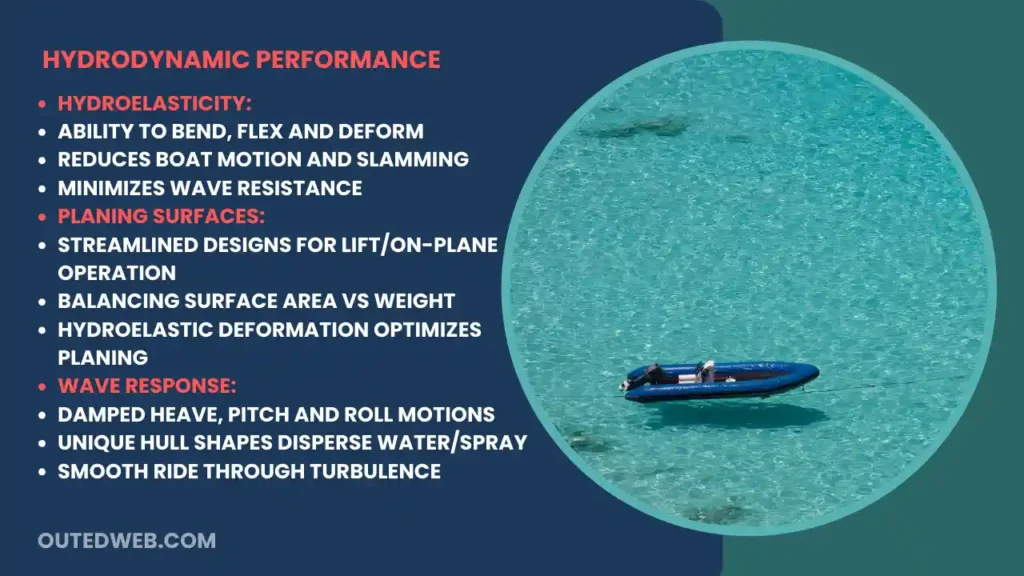
Wave Response
Now, let’s talk about what happens when you encounter those pesky waves. Believe it or not, an inflatable boat’s wave response is a thing of beauty!
As the waves come rolling in, you’ll experience a symphony of motions—heave, pitch, and maybe even a little roll if you’re feeling frisky.
But thanks to that trusty hydroelasticity, these motions are dampened and smoothed out, resulting in a ride that’s more “ahh” than “aaah!”
Moreover, we mustn’t overlook wave impact and water dispersion. With their distinctive hull contours and sponsons, inflatable vessels can carve through turbulence and scattered water droplets like a searing blade through butter, keeping you relatively dry and at ease.
Phew, that was quite a ride, wasn’t it? With inflatable boats, every journey is an adventure, and every wave is an opportunity to experience the true thrill of hydrodynamic awesomeness!
Numerical Modeling and Experimental Analysis
Numerical modeling and experimental analysis play a crucial role in the design and optimization of inflatable boats.
These techniques allow for a comprehensive understanding of the boat’s behavior under various loading conditions, enabling engineers to improve performance, safety, and efficiency.
Two widely used numerical modeling approaches are computational fluid dynamics (CFD) and finite element analysis (FEA), while experimental stress and strain measurement techniques provide valuable validation data.
Computational Fluid Dynamics (CFD)
CFD is a powerful tool for simulating the fluid flow around the inflatable boat’s hull. By solving the Navier-Stokes equations numerically, CFD can predict the hydrodynamic forces, pressures, and flow patterns experienced by the boat in various operating conditions.
This information is essential for optimizing the hull shape, minimizing drag, and analyzing the boat’s behavior in waves and rough water.
CFD models can also incorporate the effects of hydroelasticity, capturing the deformation of the inflatable components and its influence on the overall performance.
Finite Element Analysis (FEA)
FEA is a numerical technique used to analyze the structural behavior of the inflatable boat components, such as the rigid hull, inflatable sponsons, and fabric materials.
By discretizing the structure into finite elements, FEA can predict the stresses, strains, and deformations under various loading scenarios, including slamming, wave impacts, and internal pressurization.
This information is crucial for ensuring the structural integrity of the boat and preventing failures. FEA models can also incorporate the nonlinear behavior of inflatable materials, enabling accurate simulations of their response to external forces.
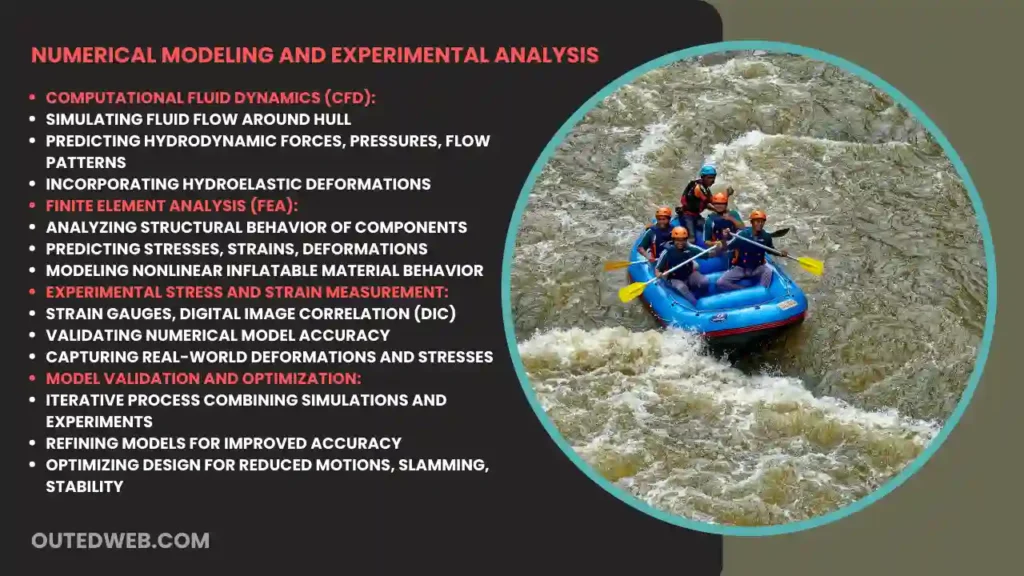
Experimental Stress and Strain Measurement
While numerical modeling provides valuable insights, experimental validation is essential to ensure the accuracy and reliability of the simulations.
Strain gauges, digital image correlation (DIC), and other measurement techniques can be employed to capture the actual deformations and stresses experienced by the inflatable boat components during testing.
This experimental data is invaluable for validating and refining the numerical models, ensuring that they accurately represent the real-world behavior of the boat.
Model Validation and Design Optimization
The combination of numerical modeling and experimental data enables an iterative process of model validation and design optimization.
By comparing the simulation results with experimental measurements, discrepancies can be identified and addressed, leading to improved model accuracy.
Once validated, the numerical models can be used to explore a wide range of design parameters and operating conditions, guiding the optimization process to achieve the desired performance targets, such as reduced motions, minimized slamming accelerations, and enhanced stability.
Applications and Use Cases of Inflatable Boats
Inflatable boats have several applications and use cases:
Recreational Boating
Inflatable boats are popular for recreational purposes due to their portability, ease of storage, and relatively low cost.
They are commonly used for activities such as fishing, diving, and general boating. Their inflatable construction allows them to be easily transported and launched from various locations.
Search and Rescue Operations
Inflatable boats are widely used in search and rescue operations due to their maneuverability, durability, and ability to operate in shallow waters.
Organizations such as the Royal National Lifeboat Institution (RNLI) employ inflatable boats for inshore rescue missions. Their flexibility and hydroelastic properties can potentially improve performance in waves, reducing motions and slamming accelerations.
Military and Law Enforcement
Inflatable boats, particularly rigid-hulled inflatable boats (RIBs), are utilized by military and law enforcement agencies for various purposes, including coastal patrol, interdiction, and special operations. Their high-speed capabilities, stability, and operational versatility make them suitable for such applications.
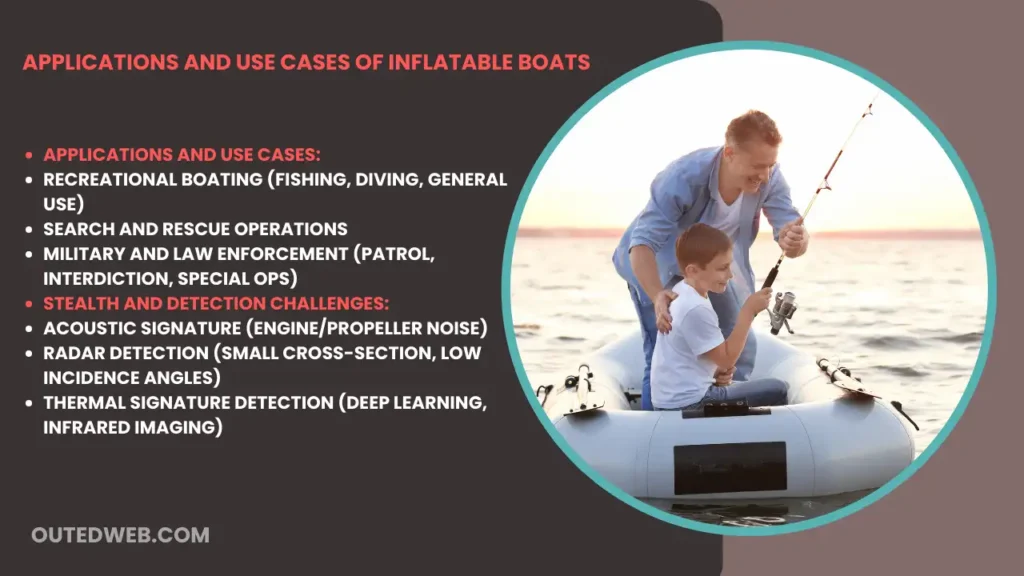
Stealth and detection challenges:
While inflatable boats are valued for their operational capabilities, they also present unique challenges in terms of stealth and detection:
Acoustic signature: Inflatable boats, especially rigid-hulled inflatable boats, produce distinctive underwater sound signatures with strong tones between 70 and 400 Hz, related to engine and propeller rotation. These acoustic signatures can potentially aid in their detection.
Radar detection: Small rubber inflatable boats can be challenging to detect using conventional radar systems. However, synthetic aperture radar (SAR) systems have shown potential in detecting small inflatable boats, particularly those used by refugees attempting to cross maritime borders. Factors such as low incidence angles and cross-polarization can improve the detectability of these boats.
Thermal signature: Deep learning methods, such as Faster R-CNN with ResNet101, have demonstrated effectiveness in detecting small inflatable boats and people in thermal infrared images under various environmental conditions.
While inflatable boats offer advantages in terms of portability, maneuverability, and flexibility, their unique characteristics also present challenges in terms of stealth and detection, which are important considerations for military and law enforcement applications.
Environmental Considerations
Environmental Considerations are crucial when it comes to inflatable boats. These vessels may seem harmless, but their impact on their surroundings can be significant. Let’s dive into this topic with an open mind and a touch of excitement!
Noise Signatures and Impact
The purr of an engine disrupts the tranquility. Inflatable boats, while compact, can produce a surprising amount of underwater noise.
This acoustic signature, often characterized by strong tones between 70 and 400 Hz, is closely tied to the engine and propeller rotation. As the boat’s speed increases, so does the intensity of the sound waves.
Now, what’s the big deal, you might ask? Well, my friend, these seemingly innocent noises can have far-reaching consequences for aquatic life.
Think of a pod of dolphins trying to communicate amidst the cacophony or a school of fish struggling to navigate the noise pollution. It’s a real underwater party foul!
Wake Patterns and Shoreline Erosion
Have you ever watched a boat glide across the water, leaving behind a mesmerizing trail of waves? While visually captivating, these wake patterns can pack a punch when it comes to shoreline erosion.
It’s like a tiny, inflatable Godzilla stomping on the beach, one ripple at a time. And let’s not forget about the potential impact on sensitive habitats, such as marshes and wetlands, where the wake patterns can disrupt the fragile balance of these intricate ecosystems.
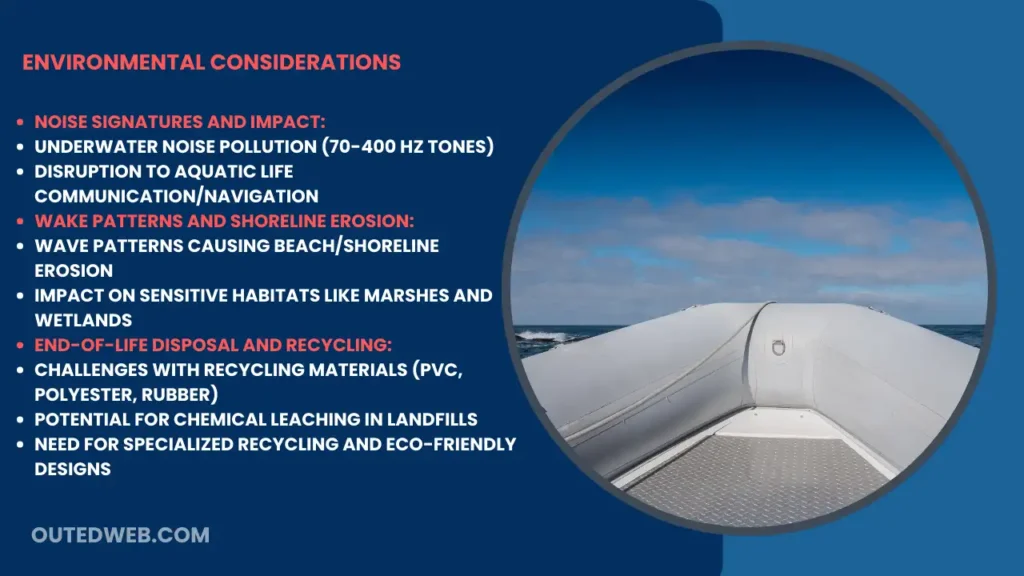
End-of-Life Disposal and Recycling
Now, let’s talk about the elephant in the room—or, should I say, the inflatable boat in the landfill? These vessels, constructed from various materials like PVC, polyester, and rubber, can pose a challenge when it comes to proper disposal and recycling.
A graveyard of deflated boats is slowly breaking down and releasing harmful chemicals into the environment.
There are innovative solutions on the horizon, like specialized recycling facilities and eco-friendly boat designs. It’s our responsibility as conscious consumers and nature lovers to ensure that these vessels don’t become a burden on our planet once their adventures come to an end.
Emerging Technologies
The world of inflatable boats is about to embark on a thrilling tech revolution! We thought these vessels had reached peak awesomeness, but the future holds some incredible innovations that will blow your mind.
Advanced Materials and Construction
Think of a boat that’s not only lightweight and portable but also virtually indestructible. We’re talking about cutting-edge materials like carbon fiber, kevlar, and advanced composites. These ones can withstand the roughest waves and harshest conditions, making your adventures even more epic.
With 3D printing technology, we could soon see customized inflatable boats tailored to your specific needs. Want a built-in cup holder for your favorite beverage? No problem! Is a personal hot tub on board? Why not? The possibilities are endless!
Autonomous Operation and Sensing
With advanced sensors, GPS, and artificial intelligence, these inflatable boats can map out the perfect course, avoiding obstacles and even adjusting to changing weather conditions.
Conceive drones flying overhead, providing real-time data and imagery, ensuring your journey is as smooth as a dolphin’s belly slide. It’s like having your very own personal reconnaissance team, keeping you informed and safe every step of the way.
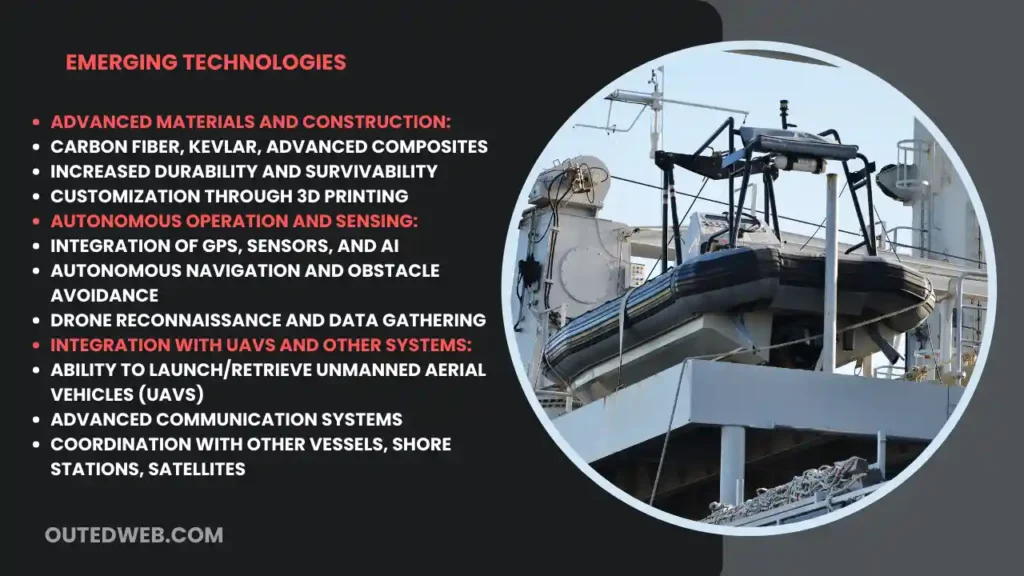
Integration with UAVs and Other Systems
Speaking of drones, what if your inflatable boat could launch and retrieve its unmanned aerial vehicles (UAVs)? It’s like having a personal air force at your command, ready to scout ahead, deliver supplies, or even provide aerial support in emergency situations.
And that’s just the beginning! With the integration of advanced communication systems, you could seamlessly coordinate with other vessels, shore-based stations, or even satellite networks. It’s like having a high-tech command center right on board your humble inflatable boat.
Frequently Asked Questions
Ah, the age-old questions that keep us all pondering the mysteries of inflatable boats! Fear not, my friends, for I shall endeavor to enlighten you with answers that are equal parts informative and entertaining. Brace yourselves for a journey into the depths of inflatable boat knowledge!
What Are the Main Differences between RIBS And IBS?
Well, it’s the classic battle of the rigid inflatable boats (RIBs) versus the inflatable boats (IBs)! RIBs, as the name suggests, have a sturdy, rigid hull complemented by those oh-so-huggable inflatable tubes.
IBS, on the other hand, rely solely on the inflatable components for their structural integrity. It’s like choosing between a well-armored knight and a nimble gymnast—both have their strengths and weaknesses!
What Materials Are Commonly Used for Inflatable Boat Construction?
As we mentioned earlier, when it comes to inflatable boat construction, we’re talking about materials that are tough as nails yet lightweight and flexible.
Think PVC, polyester, and rubber—the perfect trifecta of durability, buoyancy, and pliability. It’s like dressing your boat in a suit of armor made from stretchy, waterproof fabric!
How Are Planing Surfaces Optimized for Inflatable Boats?
Ah, the age-old quest for the perfect planing surface! For inflatable boats, it’s all about finding that sweet spot between lift and stability.
Designers tinker with shapes, angles, and materials to create surfaces that can effortlessly glide over the water while maintaining a steady course. It’s like a delicate dance between hydrodynamics and buoyancy!
What Design Factors Influence an Inflatable Boat’s Wave Response?
Just think of a surfer riding a gnarly wave, but instead of a board, it’s an inflatable boat! The key to a smooth ride lies in the careful consideration of factors like hull shape, tube design, and weight distribution.
It’s a delicate balancing act, where even the slightest tweak can mean the difference between a serene cruise and a wild-bucking Bronco adventure!
How Can Numerical Modeling Aid in Inflatable Boat Design?
It’s like having a crystal ball that can peer into the future performance of your inflatable boat design. With powerful computer simulations, engineers can virtually test out different hull shapes, material properties, and even wave conditions before ever dipping a toe in the water.
It’s like having a digital wind tunnel for your inflatable vessel, allowing you to tweak and optimize every aspect until it’s performing like a well-oiled machine. Who needs physical prototypes when you’ve got the power of ones and zeros on your side?
What Are the Advantages of Inflatable Boats for Search And Rescue?
When it comes to search and rescue missions, inflatable boats are like the superheroes of the maritime world! Their lightweight, compact nature means they can be quickly deployed and transported to even the most remote locations.
Plus, with their incredible maneuverability and shallow draft, they can access areas that larger vessels can only dream of. Imagine being able to navigate through narrow channels, shallow waters, and even surf zones with ease!
It’s like having a versatile, all-terrain vehicle for the open waters. And let’s not forget their durability—these inflatable wonders can take a beating and keep on floating, ensuring the safety of both crew and survivors.
How Can Inflatable Boats Be Detected by Radar And Thermal Imaging?
In the world of maritime surveillance, inflatable boats can be like tiny needles in a vast haystack. But fear not, for modern technology has equipped us with powerful tools to detect these elusive vessels.
Radar systems, with their ability to detect even the smallest of targets, can pick up the distinctive signatures of inflatable boats.
And when combined with thermal imaging, which can spot the heat signatures of engines and passengers, these stealthy crafts don’t stand a chance of staying hidden. It’s like having a high-tech pair of X-ray goggles that can see through any disguise!
Final Verdict
Our exploration of the captivating world of inflatable boats unveils a crucial truth: these adaptable vessels transcend mere aquatic recreation. They embody a harmonious union of practicality, ingenuity, and an unyielding zest for adventure.
From their unassuming origins as basic rubber rafts, inflatable boats have morphed to accommodate the ever-shifting demands of explorers, rescue crews, and adrenaline junkies alike. And with groundbreaking technologies on the cusp of arrival, the potential is truly boundless.
Therefore, whether you’re undertaking a daring rescue operation, traversing secluded waterways, or simply yearning for a relaxing day on the lake, an inflatable boat could very well become your loyal comrade. Embrace the voyage, treasure the memories, and persist in defying limitations, for the adventure is merely dawning!

